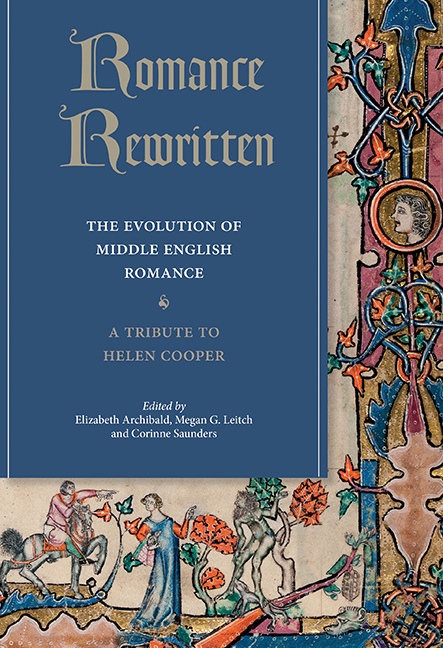Book contents
- Frontmatter
- Dedication
- Contents
- Notes on Contributors
- Acknowledgements
- Introduction. Middle English Romance: The Motifs and the Critics
- I Romance Disruptions
- II Romance and Narrative Strategies
- III Romance and Spiritual Priorities
- IV Late Romance
- 11 The Intelligence of The Court of Love
- 12 The Squire of Low Degree and the Penumbra of Romance Narrative in the Early Sixteenth Century
- 13 Contested Chivalry: Youth at War in Walter Scott and Charlotte M. Yonge
- Works Cited
- Index
- Volumes Already Published
13 - Contested Chivalry: Youth at War in Walter Scott and Charlotte M. Yonge
from IV - Late Romance
Published online by Cambridge University Press: 17 October 2019
- Frontmatter
- Dedication
- Contents
- Notes on Contributors
- Acknowledgements
- Introduction. Middle English Romance: The Motifs and the Critics
- I Romance Disruptions
- II Romance and Narrative Strategies
- III Romance and Spiritual Priorities
- IV Late Romance
- 11 The Intelligence of The Court of Love
- 12 The Squire of Low Degree and the Penumbra of Romance Narrative in the Early Sixteenth Century
- 13 Contested Chivalry: Youth at War in Walter Scott and Charlotte M. Yonge
- Works Cited
- Index
- Volumes Already Published
Summary
The chivalric revival of the nineteenth century made it possible to see medieval and new medievalist romances as upholding ideals for youth to emulate: courage, loyalty and honour, respect for women, even religious piety. Nevertheless, the Middle Ages were often seen as a violent and barbarous historical period, when most of the people were, in Charles Dickens's words, ‘the mere slaves of the lords of the land’ and all of them were in ‘slavery to the priests’. Chivalric romance faced critique from a historiographical tradition that constructed the medieval past as violently uncivil, no good example for youth. David Hume's influential History (1778) had communicated a largely negative consciousness of medieval chivalry to its successors; he speaks with some apparent approval of ‘the martial pride’ and ‘sense of personal honour and fidelity’ bred by ‘feudal institutions’, but calls chivalric customs ‘affectations’ and ‘fantastic notions’, and repeatedly emphasises medieval ‘violence’ and ‘animosities, inseparable from the feudal aristocracy’. The value of medieval chivalric literature as a moral example for youth was also threatened by its association with Catholicism. Chivalry was liable to be seen merely as an echo of what Hume called ‘the ruling passions of the age, superstition and jealousy of military honour’.
Nineteenth-century medievalist fictions of youth at war were written in the knowledge of such hostility, and often shared aspects of it themselves. Awareness of common objections to chivalry, and to the perceived violence of the medieval past in general, helped shape writers’ narrative and ideological strategies, and led them to discriminate carefully between what was to be considered truly valuable and what was excessive and dangerous in chivalry. Informed by the often negative outlook of contemporary histories of the Middle Ages, they presented some elements of chivalry in a positive light – magnanimity, honour, fidelity, chaste love – but willingly conceded the faults of others. They adopted narrative strategies of selection and thematic re-emphasis that contested the received image of medieval chivalry in order to define it along new lines. In effect, they created new chivalric romances of youth at war that were nested within broader historical accounts of the Middle Ages and responded sensitively to them. In what follows I analyse these features of nineteenth-century medievalist fiction in work by two highly popular writers of the century, Walter Scott (1771–1832) and a later author whom he strongly influenced, Charlotte M. Yonge (1823–1901).
- Type
- Chapter
- Information
- Romance RewrittenThe Evolution of Middle English Romance. A Tribute to Helen Cooper, pp. 241 - 256Publisher: Boydell & BrewerPrint publication year: 2018

